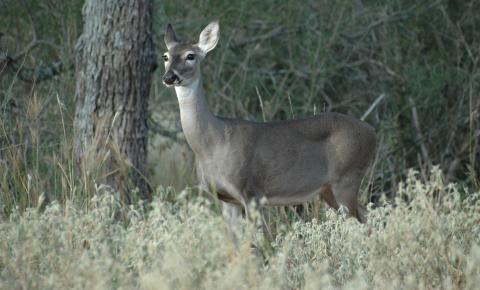Robert Bertling of Las Vegas, Nevada, has been hunting mule deer for 23 years and has been a Mossy Oak ProStaffer for 3 ½ years. He’s also sub-guiding, which is a prerequisite to obtaining a guide or an outfitter license. Robert was born and raised in Hawaii.
I was born and raised on the island of O’ahu in the town of Ewa Beach. In my younger days, we hunted the wild pigs found on many of the Hawaiian Islands. The islands also have feral sheep called Mouflon or Hawaiian black sheep. That’s what I hunted as I grew up, and I just fell in love with hunting. I started hunting at age 7, and I’ve been hunting ever since.
My parents often vacationed in Las Vegas. My dad worked maintaining roads in Hawaii, and when he retired, he decided to sell our home in Hawaii and move to Las Vegas. A year after we moved here, the state held a random lottery for mule deer hunting, and I told my dad, “Let’s try this mule deer hunting out.” We not only put in for mule deer, we put in for antelope and elk. That first year, we were drawn for some mule deer buck tags.
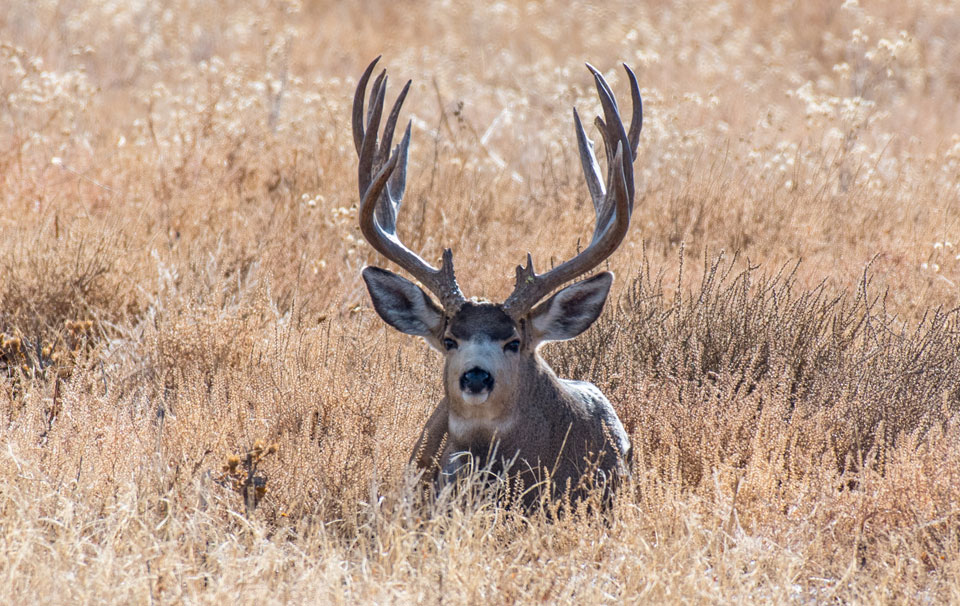
I had a rude awakening that first year, because hunting in Nevada was nothing like hunting in Hawaii. Everyone told us to purchase a quality pair of binoculars and a spotting scope and train our eyes to look for mule deer. I also learned that not all optics were the same. Better quality optics drastically increased the odds for taking mule deer. Many people spend a lot of money on their rifles and rifle scopes, thinking that will give them an advantage when hunting mule deer. But I spend my money on the best optics I can afford. My binoculars are Vortex Kaibab 15x56. I also use a Leupold Boone and Crockett HD spotting scope 20-60x80 mm. My range finder is a Leica that’s good up to 1200 yards.
One of the most difficult aspects of mule deer hunting is to learn the type of country where mule deer live. When I first moved here, people told me to glass in those high-country bowls and patches of aspen, in elevations from 7,000-10,000 feet high. But to be really honest, I’ve seen some of the biggest mule deer I’ve ever seen out here in the lowlands. We harvest a lot of big deer in the low country from 2,000-3,000 feet up.
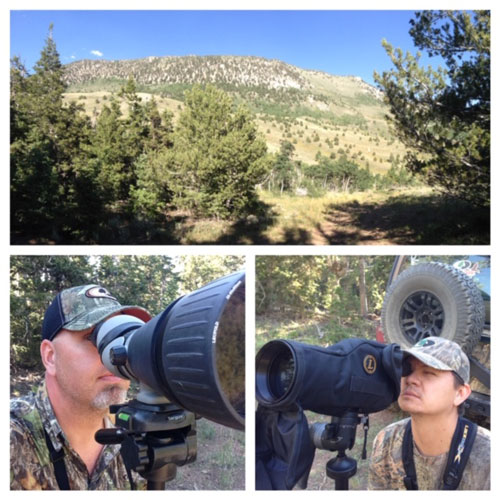 After going to the high country and looking for mule deer when I first started hunting out here in Nevada, I began to slowly but surely learn that I could find more mule deer bucks around alfalfa fields than in the high mountains. Even when there’s no agriculture like alfalfa fields, I still locate plenty of mule deer in big fields of sagebrush - sometimes 4-5 feet high. Besides Nevada, I also hunt in Arizona. However, in Arizona, I hunt just the opposite way that I hunt in Nevada. In Arizona, I go into the high country and look for those mountain mule deer.
After going to the high country and looking for mule deer when I first started hunting out here in Nevada, I began to slowly but surely learn that I could find more mule deer bucks around alfalfa fields than in the high mountains. Even when there’s no agriculture like alfalfa fields, I still locate plenty of mule deer in big fields of sagebrush - sometimes 4-5 feet high. Besides Nevada, I also hunt in Arizona. However, in Arizona, I hunt just the opposite way that I hunt in Nevada. In Arizona, I go into the high country and look for those mountain mule deer.
The secret to hunting mule deer in the high country is to buy the best pair of boots you can. I like my Kenetrek Mountain Extreme boots that come up to right below my calf. Where I hunt mule deer, there’s a lot of shale rock, and you have to climb numbers of mountains. Those boots have a mid-sole stiffening agent, and the soles are also somewhat narrow, so when you step down, you don’t have a big, bulky sole that can cause you to slip. The design of these boots came from the mountain-climbing industry. Another advantage is when you wear the soles out on these boots, you can send the boots back to the company, and for $50, they’ll replace the soles of both boots. Now these boots aren’t cheap - I paid $400 for them. But if you don’t have the best footwear you can purchase, and you start getting blisters, then you’re pretty much done mule deer hunting.
My biggest mule deer ever scored 165 and was a typical 4x4 with antlers about 27-inches wide. I took him with a .280 Browning. He was about 260 yards away when I squeezed the trigger. When I’ve been helping to guide and hunt, I’ve found that most of the time, the mule deer we take usually will be at about 200 yards. I took that mule deer about 45 minutes from where I’m living in Las Vegas. I found him in mid-September and opening day was October 6. He was up at about 6500 feet of elevation. I spotted him feeding. When he went over the top of a ridge, I went after him with the wind in my face. Once I reached the ridge the buck had gone over, I started glassing. I needed about 30 minutes to find him bedded under a cedar tree. The first thing I did was range him, so that I knew he was at 260 yards. Then I whistled at him to get him to stand up. When I squeezed the trigger, the buck dropped in his tracks. All that was the fun and easy part. Then I had to make two trips in and out, because I skinned and deboned him. I was hunting on BLM land, and I had to draw for that tag.
On one of my most memorable hunts, I took a 16-year-old young man on his first mule deer hunt. In the area that he drew to hunt in, there were many tags given out, so there was a lot of hunting pressure. In that area, most people hunt the high country, so we went to the low country to a big sage field. The mule deer was bedded down, but we were able to see his antler tips above the sage. I said, “That looks like a good buck. Do you want to take him?”
The buck was about 400 yards away from us when we saw him. So, when my hunter said he wanted to take that buck, I knew we’d have to get above and closer to him. We slipped down a ridge that went close to where the buck was bedded, and I got my hunter to within 180 yards. I whistled, the buck stood up, and my hunter fired. The buck only went about 30 yards before he piled up.
The buck had been bedded in a draw. We got on the ridgeline, staying off the top of the ridge to keep from being silhouetted as we moved closer to the deer. The buck was facing down the ridge, and we came up behind him. My hunter was shooting a .243, and I wasn’t really surprised that the .243 put the buck down quickly. Many hunters think you have to have a 7mm or a .300 Win Mag to take mule deer. But the truth is, it’s not the caliber of bullet you shoot that downs the deer, it’s how accurately you can shoot and hit the vitals.
My young hunter was really excited because not only was that his first mule deer, it was the first buck he’d ever taken. The buck scored about 155 inches and was a really nice deer.
If you’re coming to Nevada to hunt mule deer, you have to understand that most of the tags issued go through a lottery. I’ve been on the waiting list for four years and am still waiting to draw a buck tag for Nevada. That’s one of the reasons I hunt Arizona as well as Nevada, because you can get a buck tag over the counter in Arizona for archery only. You can purchase that tag in August, but if you don’t take a buck during the early season with archery tackle, you can hunt the late season during December with that same tag. If you tag out in December, you can purchase another archery tag over the counter in January. If you don’t tag out in January, you can use that same tag to hunt mule deer in August and December with a bow. If you hunt with a bow, and you buy a bow tag in January, you can hunt three seasons with that tag to try and fill your tag, which means you can hunt more, see more mule deer and find the deer you want to take at three different times of year in Arizona. I’ve taken four mule deer bucks in Nevada and two in Arizona, but I’ve helped guide five other hunters to take their mule deer.
Becoming A Hunting Guide
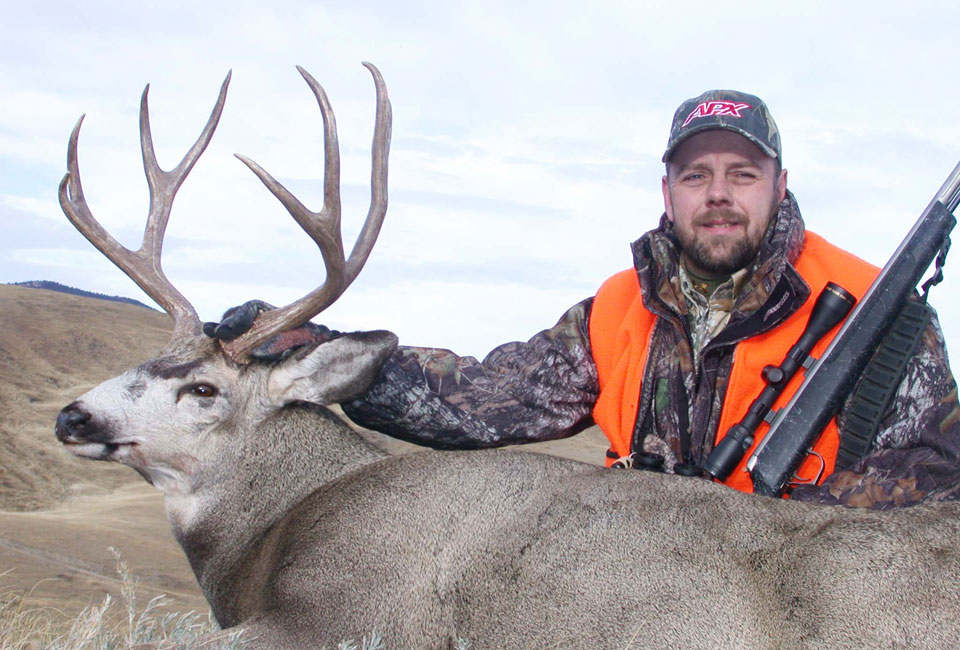
I really want to get an outfitter’s license, so as a sub-guide my main job is to scout for and find nice mule deer bucks for my outfitter’s clients. The outfitter usually will talk to the client to find out what size buck he wants to take. Then the sub-guides go out and scout for a mule deer buck like what that client wants to take. We’ll go to the area that the hunter has drawn a tag for and start glassing and taking pictures of the bucks we find.
I use a Phone Skope, which allows me to put my cell phone right up to my spotting scope or right up against my binoculars and shoot a picture of the bucks I find. Those Phone Skopes are a big help when I’m scouting. If you’re coming out West to hunt a mule deer, you may really enjoy having a Phone Skope to take pictures of the bucks you spot.
In Nevada, a sub-guide has to put in about 3,000 hours of hunting and scouting to qualify to take the test to be a guide or an outfitter. My job allows me to hunt almost every weekend, and I’ve got quite a bit of vacation time. So, when I’m not working, I’m scouting and trying to fulfill the requirements to take the test for a guide or an outfitter’s license. I also get flex time, which means for every 8 hours I work, I get one hour of flex time, and I can take that flex time whenever I want. I mainly scout around Las Vegas, because if I’ve built up 4-5 hours of flex time, I can use those hours to scout in the morning or afternoon before or after work. I concentrate my scouting primarily in the southern part of the state, where I can spend more time building up sub-guide hours.
That’s the good news. The bad news is as a sub-guide, I don’t get paid. But those are the hours that I have to put in if I want to become a guide and/or outfitter. Another factor that determines how much time I get to scout is the number of mule deer hunters that my outfitter books and the area they draw to hunt mule deer.
My outfitter also outfits for elk hunting about 3 hours north of Las Vegas. I haven’t gotten to scout for elk on any of those hunts. I’ve mainly been the horse. Once an elk hunter downs an elk, if the elk falls in an area that’s hard to get a 4-wheeler or a horse to, the sub-guides go in, skin and field dress the elk and pack out the meat. That’s what I mean when I say I’m the horse.
Sub-guide Equipment for Hunting Mule Deer and Elk
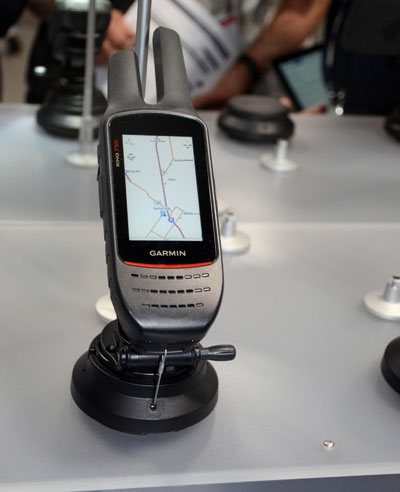 When one of my outfitter’s clients takes an elk, I’ll usually get called, and the outfitter will ask me if I’ll pack out the meat. He gives me the GPS coordinates of where he wants to meet me and the coordinates for where the elk is. So, if I can go, I pack up my frame pack and head for the mountains.
When one of my outfitter’s clients takes an elk, I’ll usually get called, and the outfitter will ask me if I’ll pack out the meat. He gives me the GPS coordinates of where he wants to meet me and the coordinates for where the elk is. So, if I can go, I pack up my frame pack and head for the mountains.
My hand-held GPS receiver is a critical tool for scouting, for packing out meat and for getting in and out of the mountains by the shortest route. I also use the onX app on my GPS and the GPS in my cell phone. For my hand-held, I use a Garmin GPS that also has a radio. The outfitter has the same type of Garmin that I have, and once I’ve got my GPS coordinates, I can talk to my outfitter as I start getting closer to where he or the elk is.
I’ve found that the radio in my Garmin GPS gives me about 2 miles of service from the outfitter and his GPS. To be really honest, I didn’t think I’d have that much range, because both me and my outfitter will be surrounded by mountains most of the time. Although a GPS with a radio is not cheap, when you’re in and out of the mountains as much as I am, it’s absolutely worth the price.
I have onX on my cell phone, and using the system I do, I can transfer the information from my onX map in my cell phone to my Garmin GPS, and that’s extremely helpful when you’re navigating in the mountains. I advise anyone who’s going to be hunting with a buddy to have some form of communication, so you can help each other if one of you takes an elk or a mule deer, or if you have a problem that you need someone else to help you with while hunting.
Another piece of equipment that I’ve found extremely useful is my frame pack. I like an Eberlestock pack because it has aluminum rails that you can bend. Then your frame pack can be customized to your back which allows you to carry more meat comfortably. I also like the quality of the straps that come across your shoulders on this pack with thick padding. There’s a comfort factor that I haven’t found with other frame packs, although it’s not considered to be one of the lightest stock packs on the market. When you’ve got a long way to go with a pack full of meat, comfort becomes very important. The Eberlestock Just One Backpack has a variable size from 2,900 to 5,425 to be used as a day pack, a weekend pack or for carrying a load of meat and can easily carry 80-90 pounds as far as I have to go.
Another critical key when you’re looking for a pack to go big game hunting is to make sure that you can adjust the pack, so that the weight you’re carrying is resting on your hips and not on your shoulders. By having the weight in the center of your body, you can go up and down mountains much easier, and the weight doesn’t seem nearly as heavy as if all that weight is on your shoulders.
What You Need to Hunt Mule Deer
When I talk with people who want to go mule deer hunting and they ask me what they need to know, I explain that the first thing they need to know is that their patience may be tested when you hunt mule deer. You glass, glass, glass, before you ever start stalking and trying to get in for the shot.
The second thing I’ll tell them is to make sure you get quality optics to go on this hunt, because you can’t hunt a mule deer until you find him, and most of the time, to locate him, you’ll need good quality optics. So, plan to spend some money to get the best optics you can afford.
The third thing that I advise is get the best pair of boots that you can afford, and make sure you understand the difference between the kind of boots you have to use to climb mountains and the type of boots that you wear most of the time hunting on flat or relatively flat ground.
Finding mule deer is more about how you look for mule deer than where you look for them. The mule deer that we locate don’t look like most of the mule deer you’ll see in magazines and online. Mule deer have white faces, so you’re looking for a patch of white that will be in the brush under the shade of a tree or in a place where there shouldn’t be a patch of white. We’re also looking for a black swish. Mule deer have black tails, and they swish them back and forth occasionally. The third thing we’re looking for is white or brown antler tips above the brush. The rump of a mule deer is white, so when you see a black tail move across a white background, that tells you a mule deer is there. Also, be prepared to hike. We have to go where the mule deer go. We very rarely get to go where we want to go. Try and be in as good a shape as you can be before you get here. These are all important keys that can make your hunt not only more successful, but also more comfortable.
If you’re not going on a guided hunt, but planning to hunt with a buddy on public land, get a good pack. I don’t know how many hunters have come out here to hunt without a guide, and the last thing they think about is how they’re going to get the meat, the head, the horns and the hide out of the mountains or lowlands after they take their mule deer. Spend a little time on the Internet learning about the type of pack, boots and optics that are best for hunting mule deer. Talk to other hunters on Facebook in mule deer groups, and contact the Mule Deer Foundation to learn all you can about the animals, the habitat and what you can expect from a mule deer hunt.
If you’re hunting with an outfitter, talk with him. Learn about what kind of weather to expect when you get out here, and get him to send you an equipment list. Also ask him if he knows the guide you’ll be hunting with, so you can get to know that guide before you meet him in camp. The more you know, and the better you’re equipped when you hunt mule deer, the greater your odds of success will be.














